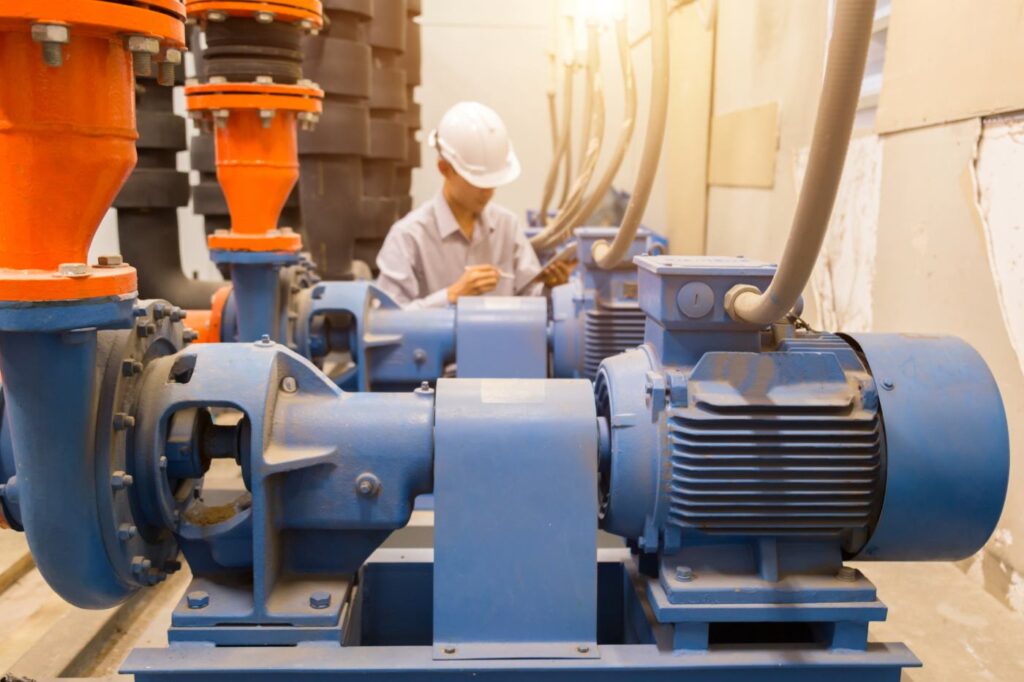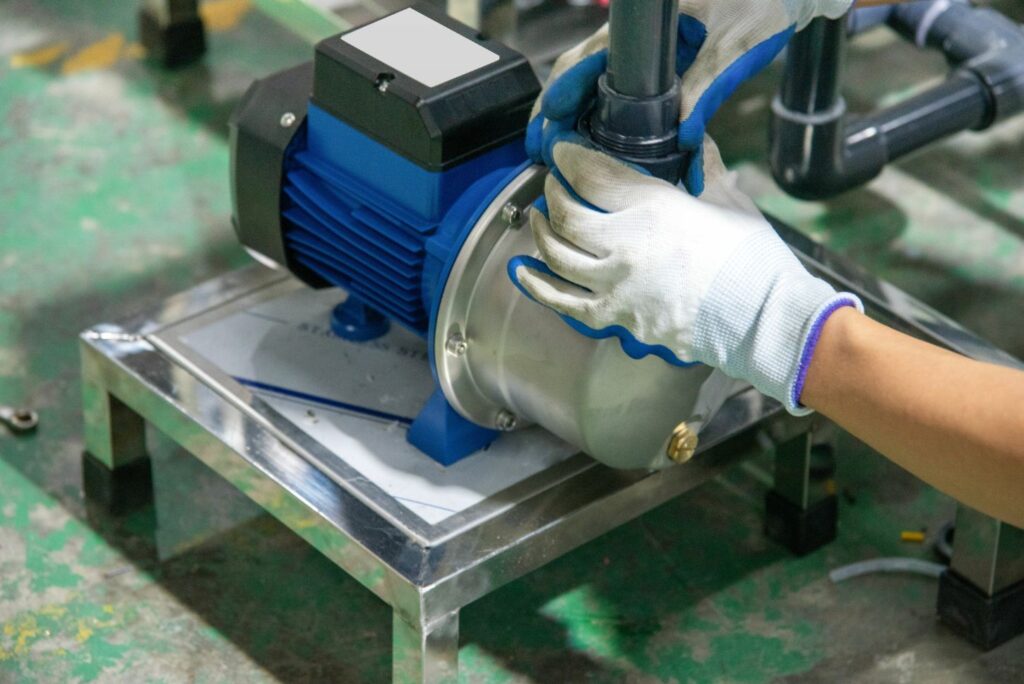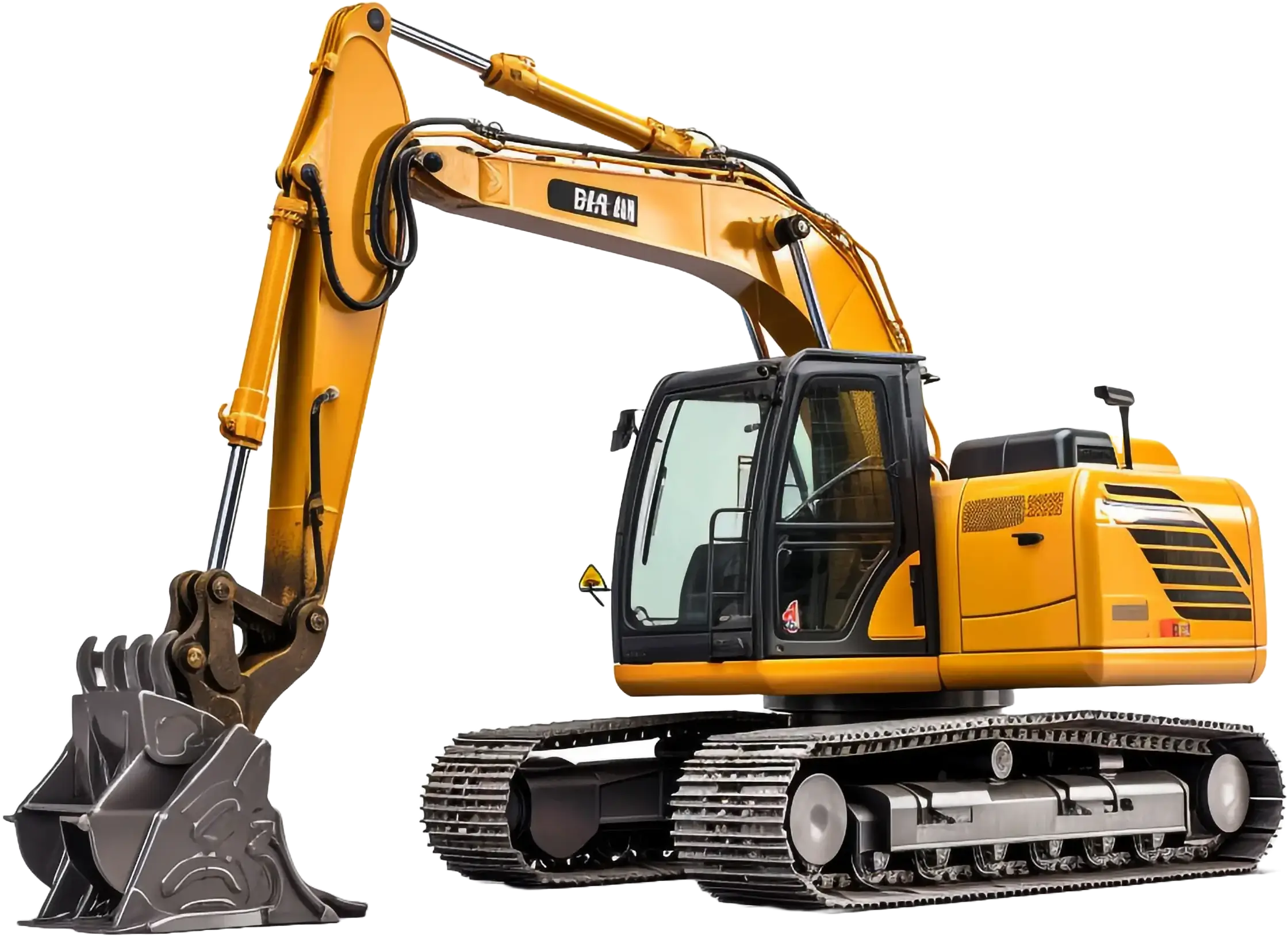Reliable pumps form the backbone of many industrial operations, ensuring efficient fluid movement, process continuity, and overall productivity. Pumps play critical roles across various sectors, including manufacturing, construction, mining, and wastewater management, making effective maintenance and repair essential. Unfortunately, pumps frequently experience issues such as leaks, reduced flow rates, unusual vibrations, or complete failures, all of which can halt production and drive up operational costs.
Prompt and effective industrial pump repair is crucial for minimizing downtime and protecting against substantial financial losses. Common pump types, including centrifugal, hydraulic, and grinder pumps, each present unique challenges and require specialized repair techniques. For instance, hydraulic pump repair is often needed to address high-pressure system malfunctions, seal deterioration, or fluid contamination. Meanwhile, grinder pump repair becomes critical when dealing with blockages or wear caused by abrasive solids.
This guide aims to equip industry professionals and technicians with practical steps for accurately diagnosing and fixing pump-related problems. Whether you’re undertaking a general industrial pump repair or specifically tackling a hydraulic pump repair, understanding these procedures will empower you to maintain optimal pump performance and reliability, ensuring consistent industrial efficiency.
Understanding Industrial Pump Types

Industrial pumps are critical components across numerous industries, including manufacturing, wastewater treatment, and oil and gas. Understanding their various types is essential for proper selection, operation, and, crucially, effective industrial pump repair. This section delves into some of the most common industrial pump categories.
Centrifugal Pumps
Centrifugal pumps are arguably the most ubiquitous type of industrial pump. They operate by converting rotational kinetic energy into the hydrodynamic energy of the fluid flow. An impeller rotates within a casing, drawing fluid into the impeller’s eye and expelling it radially at high velocity into the pump casing. This design makes them ideal for high flow rates and low to moderate viscosities. Their simplicity and robust design contribute to their widespread use. Common applications include water supply, chemical transfer, and HVAC systems. While generally reliable, wear and tear on impellers, bearings, and seals necessitate regular maintenance and occasional industrial pump repair to ensure optimal performance.
Hydraulic Pumps
Unlike centrifugal pumps that move fluids, hydraulic pumps are specifically designed to generate hydraulic power by converting mechanical energy into hydraulic energy. They draw fluid from a reservoir and force it into a hydraulic system, creating the pressure necessary to power cylinders, motors, and other actuators. Examples include gear pumps, piston pumps, and vane pumps, each with distinct characteristics regarding efficiency, pressure capability, and flow rate. Due to the high pressures involved, precision is paramount in their operation and maintenance. When issues arise, specialized knowledge is required for hydraulic pump repair. Common problems that necessitate hydraulic pump repair include internal leakage, worn seals, and contaminated fluid, all of which can significantly impact system efficiency and power.
Grinder Pumps
Grinder pumps are a specialized type of pump designed to handle wastewater containing solids. Unlike conventional sewage pumps, grinder pumps feature a cutting mechanism that grinds up solids, such as rags, plastics, and sanitary products, into a fine slurry before pumping them through small-diameter pipes. This capability makes them invaluable in residential, commercial, and industrial settings where gravity flow is not feasible or where solids are a concern. While highly effective, the grinding mechanism and the harsh environment they operate make them susceptible to wear. When a grinder pump malfunctions, grinder pump repair typically involves addressing clogs, wear on the cutter blade, or motor issues. Regular inspection and timely grinder pump repair are crucial to prevent sewage backups and maintain system integrity.
Positive Displacement Pumps
Positive displacement pumps operate by trapping a fixed volume of fluid and then forcing that volume into the discharge pipe. Unlike centrifugal pumps, their flow rate is relatively constant regardless of system pressure, making them suitable for applications requiring precise dosing or high pressures. This category encompasses a wide variety of designs, including rotary lobe pumps, progressive cavity pumps, screw pumps, and diaphragm pumps. Each type excels in specific applications, from highly viscous fluids to abrasive slurries. Due to their precise nature and often complex internal mechanisms, industrial pump repair for positive displacement pumps can be intricate, focusing on wear plates, rotors, stators, and diaphragms to maintain their volumetric efficiency.
Common Industrial Pump Problems and Their Causes
Industrial pumps are the workhorses of numerous operations, but like any mechanical system, they are susceptible to a range of problems that can compromise performance and result in costly downtime. Understanding these common issues and their root causes is the first step toward effective industrial pump repair.
Leaks and Seal Failures
One of the most visible and frequent problems in industrial pumps is leakage, often stemming from seal failures. Seals, whether mechanical seals or packing, are designed to prevent fluid from escaping the pump casing. Causes for seal failure include improper installation, wear due to abrasive fluids, shaft misalignment, excessive vibration, or operating the pump outside its design parameters (e.g., extreme temperatures or pressures). Timely industrial pump repair for leaks is crucial, as even minor leaks can lead to significant product loss, environmental contamination, and accelerated wear on other pump components due to loss of lubrication.
Cavitation Issues
Cavitation is a destructive phenomenon caused by the formation and collapse of vapor bubbles within the pump. This typically occurs when the net positive suction head available (NPSHa) is lower than the net positive suction head required (NPSHr) by the pump. The collapsing bubbles create shockwaves that erode the impeller and casing, leading to pitting, reduced efficiency, excessive noise, and vibration. Addressing cavitation often involves adjusting suction conditions, checking for clogged suction lines, or, in severe cases, requiring industrial pump repair to replace damaged components.
Vibration and Noise
Excessive vibration and noise are tell-tale signs of underlying pump problems. These can be caused by a multitude of factors, including misalignment between the pump and motor, worn bearings, unbalanced impellers, cavitation, bent shafts, or loose mounting bolts. While some vibration is normal, unusual levels can indicate impending failure and necessitate immediate attention. Proper alignment and balancing are critical preventive measures, but once issues arise, precise diagnostics and industrial pump repair are essential to prevent catastrophic damage.
Loss of Pump Efficiency and Pressure
A noticeable drop in flow rate or discharge pressure indicates a loss of pump efficiency. This can be attributed to several factors, including internal wear (e.g., increased clearances between the impeller and casing), clogged impellers, incorrect impeller trim, worn wear rings, or issues with the suction piping. For positive displacement pumps, internal leakage due to worn components can also lead to a significant drop in performance. Diagnosing the exact cause is key to effective industrial pump repair and restoring the pump to its optimal operating point.
Hydraulic System Problems Specific to Hydraulic Pumps
Hydraulic pumps, in particular, face unique challenges. Contaminated hydraulic fluid is a major culprit, leading to accelerated wear of internal components, sticking valves, and reduced efficiency. Overheating of the hydraulic fluid can also degrade seals and reduce the effectiveness of lubrication. Furthermore, issues like air in the system (aeration) or cavitation within the hydraulic lines can cause erratic operation and damage. Addressing these often requires flushing the system, replacing filters, checking for leaks, and specialized hydraulic pump repair to restore the pump’s precise pressure generation capabilities. This can involve rebuilding worn piston assemblies or replacing damaged gear sets, making hydraulic pump repair a critical aspect of maintaining hydraulic systems.
Blade Wear and Jamming Specific to Grinder Pumps
Grinder pumps, by their nature, are designed to handle solids, but this also makes them vulnerable to specific problems. The grinding mechanism’s blades can wear down over time due to abrasive materials or even chip if foreign, non-grindable objects enter the system. This wear reduces their effectiveness in comminuting solids, leading to clogging and reduced flow. Jamming can occur when oversized or particularly tough materials get lodged in the grinder mechanism. Frequent grinder pump repairs for these issues typically involve inspecting and replacing worn blades or clearing obstructions. Ignoring these signs can lead to motor overload and complete pump failure, highlighting the importance of timely grinder pump repair to ensure continuous wastewater handling. Preventive maintenance, including periodic inspection of the grinding mechanism, is key to minimizing the need for extensive grinder pump repair.
Repair Methods for Industrial Pumps

Effective industrial pump repair is crucial for minimizing downtime and extending the lifespan of critical equipment. While specific procedures vary by pump type, several general repair practices form the foundation of any successful industrial pump repair.
General Repair Practices
The repair process typically begins with the disassembly of the pump, during which the condition and orientation of all components are meticulously documented. Following disassembly, thorough cleaning is essential to remove accumulated debris, corrosion, and old lubricants, allowing for proper inspection. The next critical step is replacing the component. Worn or damaged parts such as gaskets, O-rings, and fasteners are routinely replaced. Bearings and seals, being high-wear items, are almost always replaced during a major overhaul to prevent future failures.
Seal and Bearing Replacements
Seal and bearing replacements are among the most common industrial pump repair tasks. Proper selection of the correct seal type (e.g., mechanical seal, packing) and material is vital, considering the fluid being pumped and operating conditions. Bearing replacement requires precision, ensuring correct fit, lubrication, and alignment to prevent premature failure and ensure smooth operation. Improper installation of these components can lead to immediate operational issues and necessitate further industrial pump repair.
Rotor and Impeller Refurbishment Techniques
For centrifugal and positive displacement pumps, the rotor and impeller are key components determining efficiency. Refurbishment techniques can include welding and machining to restore worn surfaces, dynamic balancing to eliminate vibration, and applying protective coatings to resist corrosion or abrasion. These processes are crucial for maintaining pump performance and preventing costly component replacement.
Repairing Hydraulic Components
Hydraulic pump repair demands specialized knowledge due to the high pressures and precision involved. This often involves diagnosing and repairing intricate internal components, such as pistons, cylinders, valve plates, and control mechanisms. Contamination control is paramount during hydraulic pump repair, as even minute particles can cause significant damage. Specialized tools and calibration are frequently required to ensure the rebuilt pump meets original specifications for pressure and flow. Effective hydraulic pump repair restores the precise power generation vital for hydraulic systems.
Addressing Grinder-Specific Repairs
Grinder pump repair techniques are unique, focusing on the cutting mechanism. This involves inspecting and replacing worn or chipped cutter blades, clearing blockages from the grinder assembly, and verifying the integrity of the grinding ring. Since these pumps handle abrasive and solid-laden fluids, wear is a common occurrence. Regular inspection of the grinding mechanism is crucial for proactive maintenance. Addressing these specific issues quickly during grinder pump repair prevents motor overload and ensures efficient wastewater handling, making timely grinder pump repair essential for system reliability.
Safety Guidelines for Industrial Pump Repair

Adhering to stringent safety standards is paramount during any industrial pump repair operation. Neglecting safety protocols can lead to severe injuries, equipment damage, and costly downtime.
Importance of Adhering to Safety Standards
Before initiating any industrial pump repair, it’s crucial to ensure the pump system is properly isolated. This includes locking out and tagging out all energy sources (electrical, hydraulic, pneumatic) to prevent accidental startup. Following established lockout/tagout procedures is non-negotiable for safe industrial pump repair. A thorough understanding of the pump’s specific hazards, including the type of fluid being pumped (e.g., corrosive, hot, flammable), is also vital.
Personal Protective Equipment (PPE)
Appropriate Personal Protective Equipment (PPE) is essential. This typically includes safety glasses or face shields, chemical-resistant gloves, steel-toed boots, and hearing protection, especially when dealing with noisy equipment or during operations that generate loud sounds. Depending on the task and fluid, additional PPE, such as respirators or chemical suits, may be required.
Safe Handling of High-Pressure Systems, Particularly in Hydraulic Repairs
When performing hydraulic pump repair, the inherent dangers of high-pressure hydraulic fluid cannot be overstated. Even a small pinhole leak can inject fluid under the skin, leading to severe injury or even death. Always relieve system pressure before disconnecting any hydraulic lines or components. Never use your hands to check for leaks; use a piece of cardboard or paper. Bleed air from the system slowly after hydraulic pump repair to prevent uncontrolled pressure surges.
Electrical Safety Measures for Grinder Pump Repair
Electrical safety is critical for grinder pump repair. Always ensure the power supply to the grinder pump is completely disconnected and locked out before commencing any work. Submersible grinder pumps often have unique electrical considerations, including sealed connections and ground fault circuit interrupters (GFCIs). Inspect all electrical cables for damage before and after the repair. Never work on live electrical circuits, and always assume circuits are live until verified otherwise with a voltage tester.
Conclusion
Understanding the diverse types of industrial pumps, recognizing common operational issues, and implementing effective industrial pump repair strategies are all crucial for maintaining seamless industrial operations. We’ve explored how centrifugal, hydraulic, grinder, and positive displacement pumps each play distinct roles, and how issues like leaks, cavitation, and vibration can compromise their performance.
Proactive maintenance is not just a recommendation; it’s an imperative. Regular inspections, proper lubrication, and immediate attention to minor issues can prevent them from escalating into major breakdowns. Timely industrial pump repair, whether it involves specialized hydraulic pump repair or addressing specific wear in a grinder pump, directly contributes to sustained efficiency and longevity. By investing in preventive measures and prompt industrial pump repair, industries can significantly reduce downtime, lower operational costs, and ensure the continuous, reliable performance of their pumping systems.




